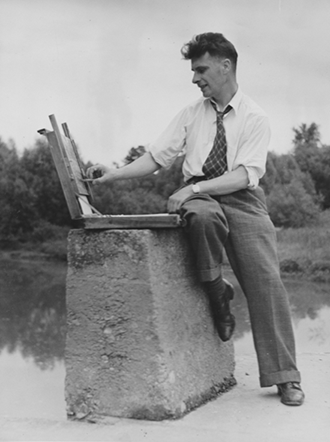George Alfred Paginton (Canadian, 1901-1988)
Inspired by the Canadian landscape like the Group of Seven, George Paginton's direct, truthful and rugged depiction of Canada served him as a personal escape. His intensity of colour and freedom of technique brought out a sense of beauty rarely seen because he preferred to paint for his own enjoyment.
Paginton spent his early years as an orphan in England and arrived in Lindsay, Ontario at age 10 as farm labour. At age 18, he began his adult life in Toronto but never forgot his early childhood struggles and fears. His first job was at Reveley’s Hardware at the corner of Sixth Street and Lakeshore in New Toronto followed by work at the Reg. N. Boxer Company, manufacturers and importers of paper hangings (as referred to in 1927 or what is known now as wallpaper). Shortly after, he spent a term at the Ontario College of Art Summer School at Port Hope in 1927 and studied under the direction of noted Canadian artists, J.W. Beatty, Frederick Haines, and Frederick Challener.
Like many recognized Canadian artists, Paginton became a commercial artist. He took contract work which included the assembling of the Simpson’s catalogue. His skills quickly developed and were rapidly noticed as he landed his first job at Photo Engravers and Electrotypers Ltd., of Toronto. Then, starting in 1927, he began a forty-three year-long and rewarding career at the Toronto Star. As an editorial illustrator, he covered events such as the construction of the Toronto subway and Toronto's City Hall, and the building of the St. Lawrence seaway. He began painting his own work in his free time.
Although roughly twenty years younger, Paginton was closely associated with the Group of Seven and even shared space in the Studio Building where many of the Group of Seven members worked. In 1941, Paginton took over Studio Four in the Studio Building from J.W. Beatty (A.Y. Jackson had Studio One) until he built his own home and studio on the shores of Lake Ontario where he continued to paint until his death in 1988. His studio is still set up as he liked it and where it remains a creative space now used by his artist son, Tony Paginton.
Paginton became close friends with A.Y. Jackson and was a pallbearer along with A.J. Casson at Jackson's funeral. Paginton was quoted in the Toronto Star (April 9, 1974) stating at the funeral that he recalled when he and Jackson shared an exhibition together during World War II, and mourned the Jackson painting that had been recently stolen from his home that he bought from Jackson for $35, 30 years earlier.

Paginton’s newspaper work, where he learned to grasp situations quickly, and his enjoyment of painting outside, where he learned to capture light in a moment, enabled him to create small panels and canvases in a single sitting. And it is in these small format works where his love of Canadian landscape is revealed. As a plein air painter, his subject matter crossed the entire country from Newfoundland and New Brunswick, through Quebec and Ontario, to Alberta and British Columbia. Rarely did he rework his sketches into larger studio canvases but there are a few.
During his lifetime, Paginton rarely exhibited his works, however he had some key shows beside some of Canada’s most recognized artists including A.Y. Jackson, David Milne, F. H. Varley, Emily Carr, Henri Masson and Kathleen Munn. One of his only international exhibitions was held in New York just before he died where his work was featured beside J.W. Beatty, Jack Bush, Lawren Harris and Illingworth Kerr. The Toronto Daily Star stated in February 1951 that Paginton passed up repeated requests from galleries and arts clubs including the St. John’s Art Club and The Guild of All Arts for an exhibition of his works. Other news features stated that he was a member of the Canadian Society of Graphic Art and the Ontario Society of Artists.
“Delighted with the bold Canadianism in the Paginton canvases,” stated J.W. Beatty to the Toronto Daily Star on November 29, 1931 while reviewing Paginton’s first art exhibition and “expressed professional appreciation” to Paginton’s paintings. (Beatty was principal of the Ontario College of Art and had been Paginton’s art instructor in 1927.)
Paginton “indicates the ability and fine appreciation…for gradations of tone…and proves his ability to handle colour…He can successfully paint the wind,” stated in a review in The Globe on March 3, 1934.
After his death in 1988, his family wanted others to see his love of Canada and they secured representation with Toronto gallerist Odon Wagner where three sold out gallery shows took place from 1998 to 2002, and arranged special exhibitions with numerous museums and galleries.
George Paginton's work is held by many esteemed private collectors and as well as public and museum collections across Canada.